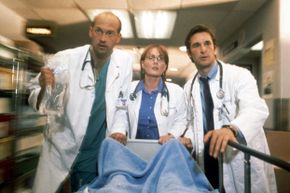Did you ever notice that no male doctor ever sat on a female patient's bed on "Ben Casey"? Or that, for a long time, all TV doctors were men? Today, TV doctors — male and female — are more likely to be flawed characters. (Look at the case of Dr. Carter on "ER," who was stabbed by a mentally ill patient and went on to become addicted to painkillers.) And while shows hire medical experts as technical advisers, writers aren't under any obligation to make any changes based on the suggestions of those pros.
It wasn't always that way. In 1951 when the first TV medical drama, "City Hospital," aired (and in the 1960s when "Ben Casey" was popular), the American Medical Association was invested in portraying medical accuracy, not preserving the story line. And for a few decades it was within the organization's right to demand script changes over concerns ranging from proper decorum to the way TV surgeons and doctors held their instruments. And in return, they'd stamp the show with the AMA seal of approval (shown at the end).
Advertisement
Many of us get a lot of our medical information from fictional TV shows. Let's look at "ER," for instance: "ER" debuted in 1994, and by 2001 one out of five doctors reported their patients were asking not only about diseases highlighted on the show, but also about specific treatments used in episode story lines. By 2002, the "ER" audience knew more about emergency contraception and human papilloma virus (HPV) after watching episodes relating to those health topics than before, and one-third of the viewers admitted they applied their TV-acquired knowledge when making personal health care decisions [source: Belluck].
That's a little scary, though, since it turns out that while the mortality rate in our real-life hospital emergency departments is 5 percent, in TV hospitals such as "Chicago Hope," "ER" and "Grey's Anatomy," it jumps to 17.5 percent [source: MedicalBag]. They're losing a lot of their fictional patients. Maybe because they're also getting a lot of things wrong.










